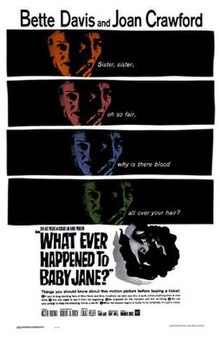| What Ever Happened to Baby Jane? | |
|---|---|
 Theatrical release poster | |
| Directed by | Robert Aldrich |
| Screenplay by | Lukas Heller |
| Based on | What Ever Happened to Baby Jane? 1960 novel by Henry Farrell |
| Produced by | Robert Aldrich |
| Starring | |
| Cinematography | Ernest Haller |
| Edited by | Michael Luciano |
| Music by | Frank De Vol |
Production company | |
| Distributed by | Warner Bros. Pictures, Inc. |
Release date |
|
Running time | 134 minutes[1] |
| Country | United States |
| Language | English |
| Budget | $980,000[2] |
| Box office | $9 million (US rentals)[3] |
What Ever Happened to Baby Jane? is a 1962 American psychological horror thriller film directed and produced by Robert Aldrich, from a screenplay by Lukas Heller, based on the 1960 novel of the same name by Henry Farrell. The film stars Bette Davis and Joan Crawford, and features the major film debut of Victor Buono. It follows an aging former child star tormenting her paraplegic sister, a former film star, in an old Hollywood mansion.[4]
What Ever Happened to Baby Jane? was released in theaters in the United States on October 31, 1962, by Warner Bros. Pictures. The film was met with critical acclaim and was a box office success. It was nominated for five Academy Awards and won one for Best Costume Design, Black-and-White, with Davis receiving her tenth and final nomination for Best Actress.
The alleged bitter rivalry between the two stars, Davis and Crawford, was pivotal to the film's initial success which helped revitalize their careers.[5] In the years after release, critics continued to acclaim the film for its psychologically driven black comedy, camp, and creation of the psycho-biddy subgenre.[5][6] The film's novel and controversial plot meant that it originally received an X rating in the U.K.[1] Because of the appeal of the film's stars, Dave Itzkoff in The New York Times has identified it as being a "cult classic".[7]
In 2003, the character of Baby Jane Hudson was ranked No. 44 on the American Film Institute's list of the 50 Best Villains of American Cinema.[8]
In 2021, the film was selected for preservation in the United States National Film Registry by the Library of Congress as being "culturally, historically, or aesthetically significant".[9]
- ^ a b Cite error: The named reference
BBFCwas invoked but never defined (see the help page). - ^ Alain Silver and James Ursini, Whatever Happened to Robert Aldrich?, Limelight, 1995 p 256
- ^ "All-Time Top Grossers", Variety, January 8, 1964, pg 69.
- ^ Multiple sources:
- Ebert, Roger. "What Ever Happened to Baby Jane? Movie Review (1962) - Roger Ebert". www.rogerebert.com.
- Tobias, Scott. "What Ever Happened to Baby Jane?". The New York Times.
- "What Ever Happened to Baby Jane? (1962) - Robert Aldrich - Synopsis, Characteristics, Moods, Themes and Related - AllMovie". AllMovie.
- ^ a b "'BLU-RAY REVIEW – "What Ever Happened to Baby Jane?"". Slant Magazine. November 6, 2012. Retrieved October 2, 2014.
- ^ "What Ever Happened To Baby Jane?". The A.V. Club. June 6, 2008. Retrieved October 2, 2014.
- ^ Itzkoff, Dave (July 12, 2012). "Whatever Happened to 'Baby Jane'? It's Getting a Remake". New York Times. Retrieved October 2, 2014.
- ^ "AFI'S 100 YEARS...100 HEROES & VILLAINS". AFI. July 4, 2003. Retrieved October 2, 2014.
- ^ Tartaglione, Nancy (December 14, 2021). "National Film Registry Adds Return Of The Jedi, Fellowship Of The Ring, Strangers On A Train, Sounder, WALL-E & More". Deadline Hollywood. Retrieved December 14, 2021.